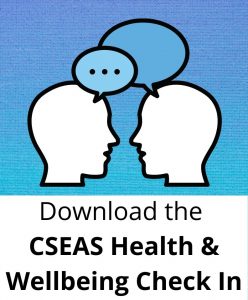 |
 |
 |
Download the CSEAS Health and Wellbeing Check In Tips
Health & Wellbeing Check In Tips
The COVID-19 pandemic has resulted in many employees remote working full-time or on a blended basis i.e. a mix of working from home and in the office. Many managers are adjusting to this model of a distributed workforce and to managing remote teams. Communication is key to maintaining good working relationships with staff. What follows are questions to consider when keeping in contact with your team; suggestions on how to check in on the health and wellbeing of each person; and guidance on what to do if you are concerned about an individual staff member.
Keeping in contact with your team:
• What method of communication is best e.g. email, phone, video calling, messaging, in person?
• Is contact needed daily, weekly or how frequently?
• Is a team or one-to-one meeting required?
• What time of day may best suit?
• Are there caring responsibilities to be aware of?
• How can connection be maintained with staff in the physical office?
• What is the topic to be discussed?
• What would make the contact as clear and concise as possible?
• How can ownership of tasks be encouraged?
• How can trust be fostered?
• What could help to track work in progress e.g. shared calendars, virtual whiteboards etc.?
• What follow-up is appropriate?
• What supports are available for managers? (see CSEAS Resources for Managers below)
Checking in one-to-one:
• In advance of any conversation, consider what you want to achieve – what is the purpose?
• Have any relevant information to hand e.g. knowledge of what person is currently working on
• Agree a mutually suitable time to speak in private in a suitable setting i.e. online, phone etc.
• Ensure there is no time pressure and distractions are kept to a minimum
• Keep in mind the individual’s personal circumstances
• Allow for informal and friendly conversation at start as would happen in an office setting
• Ask the person how they are keeping and how current arrangements are working for them
• Give the reason for your contact e.g. catch up, update on project, clarifying figures
• Invite the staff member to include anything they wish to discuss on the agenda
• Ensure the conversation is two-way by asking questions and letting the staff member respond
• Actively listen to what is being said and be open and receptive to the points raised
• Attend to any difficulties or anxiety being expressed and help identify solutions if possible
• Reflect on what you are hearing by repeating it back in your own words to show understanding
• Summarise the conversation into a few short sentences pulling together the main points
• Explore how you can best provide support and agree any follow-up
• Remember you can’t always know the answer but may be able to point in the right direction
• Signpost to other internal sources of support if appropriate e.g. HR, DLO, L&D, CSEAS etc.
Where there is a concern for a staff member:
• If the staff member sounds like they are upset or struggling, ask them if this is the case
• Invite them to tell you about what is going on for them in so far as they are able/willing
• Notice any changes in the person/their behaviour e.g. work output, attitude, mood
• Try get a sense of any work/life challenges e.g. workload, isolation, inability to switch off
• Where someone is distressed, suggest they take a moment to catch their breath/sip water
• Check what supports are available and if staff member is in touch with them e.g. family, GP
• Explore what might help to make the situation better/easier to deal with
• Ask what you could do to help – don’t assume you know the solution to the problem
• Suggest contact with senior management/HR/CSEAS for support as necessary
• Consider a plan of action e.g. reprioritising tasks, strategies for improving work-life balance
• Agree when you might touch base again to check in on how staff member is doing
• Consider making a referral to the CSEAS – discuss this with the staff member in advance*
If a staff member is not contactable for a period of time, you may need to take action e.g. try all means of contact, check if a colleague has heard from them, consult with HR, get in touch with next-of-kin etc.
Resources:
• CSEAS People Managers Guide – ‘Where can the Manager get Help and Support?’ and also, see new sections on ‘Communications’ and ‘Managing a Remote Team’ which are currently being added to the Guide – keep on eye on our website
• *CSEAS Management Referral Form – July 2020 here
Conclusion:
It is more important than ever for managers to keep in touch with staff, check in on the health and wellbeing of their team and, where they are concerned for an individual, to take the necessary steps to help the person get the information and support they need to make a positive change. By doing this, managers will be well positioned to have a broad awareness of issues impacting on their staff. Remember, the CSEAS remains available to both management and staff at this difficult time.





